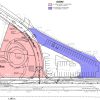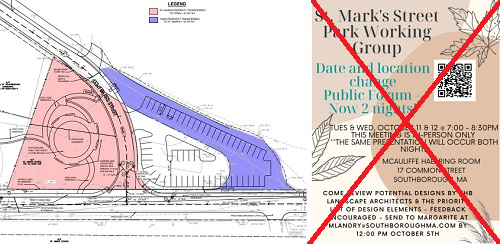Above: This week, the Town announced a planned land swap with St. Mark’s in the triangle of the street and park project, plus that the forum to discuss the design of the park is now postponed indefinitely.
At next Thursday’s Town Meeting, the Select Board will ask voters to say no to a Citizen’s Petition Article to accept land from St. Mark’s School as a donation.
Chair Kathy Cook announced that the school has already agreed to swap parcels of the St. Mark’s “triangle” to allow for the project to proceed with a “pocket park”, relocated intersection, and parking for the school’s sports fields.
In related news — there was an a second announcement about the previously scheduled and rescheduled St. Mark’s Street Working Group’s Public forum. It is now postponed again.
Postponed Public Forum
Earlier today, I wrote that the public forum that I previously covered as scheduled to take place tonight was postponed at the last minute to Tuesday and Wednesday of next week. This afternoon, I read a message that came in a few minutes later. The forum is being postponed to a date after Town Meeting, to be later determined.
Select Board discussion of land swap, Citizen’s Petiton, and next steps
Cook made her land swap announcement at Monday’s Select Board meeting. She said that she believes the item will be on the Board’s October 18th agenda. At that meeting she hopes to discuss next steps, including moving ahead with construction before bringing a land ownership swap to Annual Town Meeting.
One potential option the Board will now also have to consider is whether to schedule another Special Town Meeting between next week’s and the Annual Town Meeting in late March. The possibility was raised during public comment at the end of the meeting by Town Clerk Jim Hegarty. Based on concerns discussed during the meeting, he offered it as an alternative to choosing between waiting for a March vote or plowing ahead without voters weighing in. Hegarty estimated that an additional meeting would cost $3-4K.
Cook had made it clear she was looking to get moving on construction this fall without waiting for a Town Meeting vote. She explained that if they delay too long, the Town will lose the contractor whose multiple street project bid the project was under. And if the project falls apart, they also risk having to reimburse the state for grant funds already paid.*
It was clear that the Chair hoped informing the public of an agreed upon land swap would be enough to assuage concerns expressed about the ownership issues. That was a plan that wasn’t appreciated by the Article proponents who argued that residents have railed against the Town proceeding with work on private land. They indicated that before the deal was done, St. Mark’s could walk away.
Earlier in the meeting, Cook lamented that working things out with the school’s lawyers took too long to include an Article on the Warrant for the upcoming October 13th Special Town Meeting.
It was the lack of a Town sponsored Article in the Warrant that Kevin Farrington and Debbie DeMuria say prompted them to file their Citizen’s Petition Article. The couple was concerned about leaving the dug up land as a dirt pit until after an Annual Town Meeting vote in March.
As I previously covered, their Article would allow voters to accept the portion of the triangle owned by the private school as a donation. It wouldn’t offer the portion owned by the Town to the school in return for their planned parking lot.
Cook argued on Monday that it wouldn’t be fair for the Town to go back to the school to ask for a straight donation after it had agreed to the land swap the Select Board had requested.
As was stressed in discussions that night, either land ownership change would require a 2/3 approval by Town Meeting voters. Working Group member Grant Farrington**, reminded the Board of the acrimony expressed by voters last spring over the Board seeking a vote on swapping easements after work began. He believed they would see the same reaction if they resume work before voters approve an ownership swap. He warned that continuing on that path could tank the Article.
During Monday’s discussions of the project, Select Board members Sam Stivers and Lisa Braccio pushed that the Town has spent money on other private land in the past. Stivers pointed to money spent on Chestnut Hill Farm, 84 Main Street, and the St. Mark’s Church Bell Tower. He referred to them as projects spent on private land for the benefit of the community.
It is worth noting major differences in those instances. In the first two examples the Town purchased the Preservation Restriction, legally protecting the public benefits that the community was investing in. In the third instance, the Town was supporting a project which was already under a Preservation Restriction agreement with the state (and that would protect the public benefit of the preservation project when completed). Finally, all three examples were approved by Town Meeting voters before public money was spent.
 One concern raised by the public about building a public park and road on St. Mark’s land was that the Town wouldn’t control that land. The Board had argued that its temporary license agreement protected those rights. But some residents publicly questioned the legality of that agreement. In pursuing an easement swap last spring, the Board further argued that easements would give the Town “interest” in the property to solidify continued protection of those rights.
One concern raised by the public about building a public park and road on St. Mark’s land was that the Town wouldn’t control that land. The Board had argued that its temporary license agreement protected those rights. But some residents publicly questioned the legality of that agreement. In pursuing an easement swap last spring, the Board further argued that easements would give the Town “interest” in the property to solidify continued protection of those rights.
After Town Meeting disagreed last May, the Board determined that pursuing a swap of land ownership was the best course of action. The legal agreement was likely delayed by a step taken by St. Mark’s to address other public concerns. An Archeological Study was done to reasonably rule out the possibility that the park parcel sat on an indigenous burial ground. The study didn’t take place until September with verbal findings reported to St. Mark’s just a few weeks ago.
During the discussion of the Citizen’s Petition, organizers made clear that they were opposed to more than the process and legal issues. They are against giving the school land for an expanded parking lot.
While Cook stated that the Town can’t reverse the project to return the trees taken down, DeMuria argued she would prefer to see the land returned to “green” and the school pursue a permit for parking on parcel it previously used.
One of DeMuria’s arguments was that the Town still doesn’t know how much completing the project would ultimately cost taxpayers. (The Working Group has been prioritizing and seeking feedback on park features without a cost estimate or budget.) She also argued against creating a parking lot for the school so close to downtown, which she described as double the area of the prior setup. She furthered that even the prior parking hadn’t gone through the correct permitting process.
In the back and forth, Kevin Farrington said the triangle project was initiated to create additional parking for St. Mark’s, not to create a park. (He referred to an August 2020 email between Galligan and St. Mark’s that predated discussions of a park that spoke about the parking lot. You can click links for the message and attached diagram.)
The Town has maintained that the project was initiated to fix drainage issues at the intersection. The parking redesigns stemmed from the redesigned road’s overlap with land owned by St. Mark’s. Later, the park came out of the Select Board urging the DPW to leverage available state grants to offset the costs of Town projects.
The DPW was encouraged to see if there was a way to take advantage of the state’s “Shared Streets” grants. The park with a “History Walk“, pollinator garden, and ADA Compliant paths was the idea rooted in DPW’s past discussions with stakeholders. The original History Walk concept was later simplified based on bid results which were too high. (History Walk paths to the Town Common and Old Burial Ground were removed from the Design Concept. But the Select Board later referred to the sidewalks around the project on Route 85 that link to the sidewalk to Common Street and St. Mark’s Street as a simplified version of the History Walk.) A playground concept was also scrapped because the proximity to Route 85 didn’t make sense.
Braccio emphasized that her interest in the park had always been to provide the community with an ADA compliant park. She referenced the ADA report the Town had conducted that showed even Town fields aren’t ADA compliant. She pitched that the park is a place where families that can’t take advantage of other spaces can enjoy themselves.
During the meeting, Planning Board Chair Meme Luttrell raised an issue that her Board had complained about in a letter to the Select Board. She asked if, as part of the triangle project, the Town would mitigate the removal of the old stonewall on St. Mark’s Street that was conducted without a Planning Board hearing. Cook said they would discuss that on the 18th.
Although not discussed at this week’s meeting, there is another factor that may weigh into the Select Board’s plans for how to proceed. Thanks to the discretionary ARPA funds, Board still has the ability to spend on the project without permission from Town Meeting voters. Using some of the federal funds for a project that the Town wouldn’t otherwise be able to afford is one of the potential “buckets” the Board has discussed in the past. That’s an issue that may come up in the meeting on the 18th.
The Board hasn’t yet allocated all of the ARPA funds. So far, the Board has defined the allocations it approved as consistent with the recommendations by the ARPA Committee.
*This was what I gathered that Cook was stating about the financial risks of delay. But I admit I had trouble hearing the precise words, since one of the speakers wasn’t working on Monday night. (Of all of the hybrid Owl meetings I’ve listened to since they adopted the technology, with sometimes spotty audio results, Monday’s meeting was by far the worst. Many of the Board’s and in-person audience comments were indecipherable.)
**Grant Farrington is the son of the Citizen Petition organizers. He told the Board that his view on the project and issues was independent of theirs.
Updated (10/6/22 1:13 pm): The public forum went from being rescheduled to next week (as I wrote about earlier) to postponed for a future date to be detemined.


